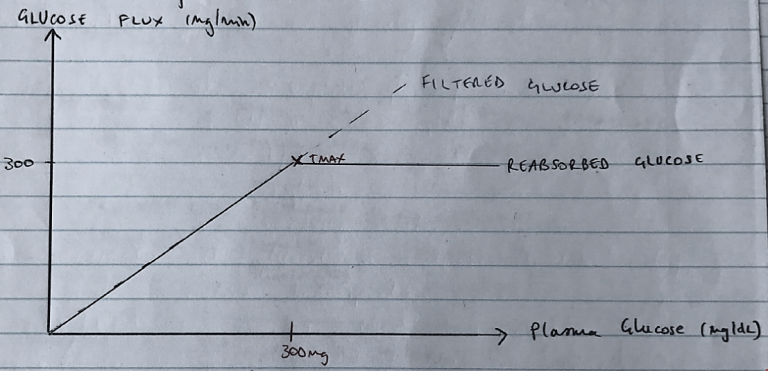H1v / 25A13: Renal handling of glucose
25A13: Exam Report
Explain how the kidneys handle glucose (70% of marks).
Outline the renal consequences of glycosuria (30% of marks).
45% of candidates passed this question.
- The expected information in this question included discussion of the sites at which glucose transport occurs (primarily glomerulus and proximal convoluted tubule) and the transport mechanisms involved including specific transporters. A discussion of the maximum transport concept was also required.
- This section required a discussion of the glucose induced osmotic diuresis and subsequent electrolyte loss. Additional marks were available for answers which recognised that this diuresis was not able to be overcome by ADH.
H1v / 25A13: Renal handling of glucose
- Glucose = dietary monosaccharide used for aerobic metabolism
- Glycosuria = excretion of glucose in urine → pathological
Renal Handling
Filtration: glucose is freely filtered
- Filtered glucose = GFR x [plasma glucose]
= 125mL/min x 80mg/dL
= 12.5dL/min x 80mg/dL
= 100mg/min
Reabsorption: all glucose is completely reabsorbed by active transport
- Na/K/ATPase creates electrochem gradient on BL membrane (active transport)
- SGLUT carries glucose coupled to Na= on apical membrane (2nd active transport)
- Enters renal ISF via GLUT transporter (facilitated diffusion) → peritubular caps
→ Concentration of glucose in tubules falls rapidly, faster than H2O
→ ∴indicates it is actively reabsorbed
- Reabsorption occurs at PCT
- Secretion does not occur
- It should NOT appear in the urine
Consequences of Glycosuria
- Loss of energy substrate
- Loss of fluid → any glucose not reabsorbed is an osmole in the tubule which prevents H2O reabsorption
- Loss of K+ → K+ secretion ∝flow ∴↑flow = ↑K+ loss
- Predisposes to UTI
